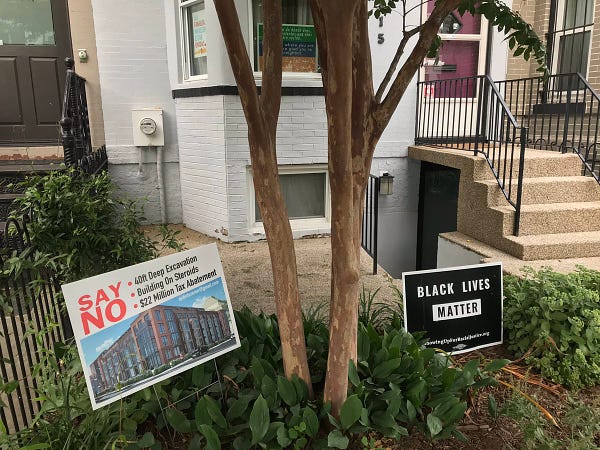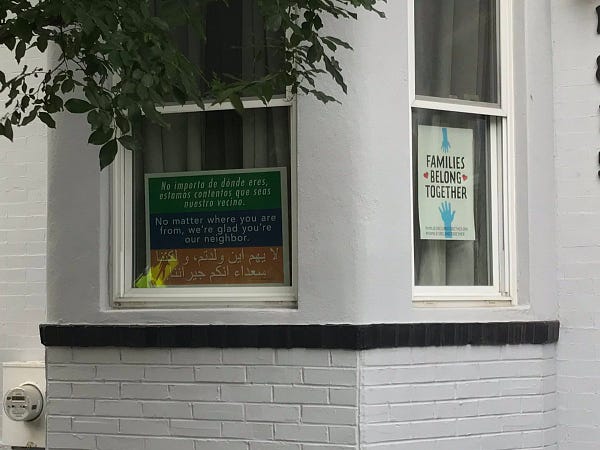We’re all familiar by now with Right-NIMBYs — conservatives who block transit and housing development in order to keep poor people and minorities out of their quiet white-flight suburban neighborhoods. These are still the most common kind, given that Republicans tend to value low-density communities while Democrats tend to value denser, more walkable places. But liberals can be NIMBYs as well, as any resident of a deep-blue state or city well knows.



But leftists can be NIMBYs as well (and remember, leftists and liberals are generally different people). In various cities, concerns over gentrification, environmental preservation, and profits for private developers have hardened into a sort of Left-NIMBY Canon — a standardized, off-the-shelf package of beliefs, attitudes, and arguments that are easy to deploy in opposition to nearly any proposed housing or transit project.
The Left-Nimby Canon goes something like this:
Allowing private developers to build market-rate housing results in the construction of “luxury” housing instead of “affordable” housing.
In addition to lining the pockets of developers, this “luxury” housing raises rents in an area, leading to gentrification and displacement.
People who argue for upzoning, easier permitting, or other policies to allow market-rate housing development are shills for developers, who don’t actually care about housing the poor or driving down rents.
These shills use the discredited economic theory of “supply and demand” to trick the public into thinking that allowing market-rate housing construction reduces rents.
Only rent control, or government-operated social housing, can reduce rents.
I’m trying to summarize rather than straw-man this package of ideas. I think it’s mostly wrong, but it’s worth engaging rather than dismissing.
Nathan J. Robinson of Current Affairs advances the Left-Nimby Canon in a recent piece entitled “The only thing worse than a NIMBY is a YIMBY”, in which he argues for a “radically democratic preservationism”. It’s a good illustration of how Left-NIMBYs think, but you shouldn’t read it without getting the other side of the story.
Market-rate housing and rents
Near the beginning of his piece, Robinson alleges that YIMBYs believe dogmatically in the power of Econ 101 and Supply-and-Demand. As evidence for this, he quotes…me!
Economist Noah Smith, a supporter of the YIMBY framework, says that progressives simply do not understand economics:
….[I]t has become an article of faith that building market-rate housing raises rents, rather than lowers them. The logic of Econ 101 — that an increase in supply lowers price — is alien to many progressives, both in the Bay Area and around the country.
But what is called the “logic” of Econ 101 is often a fairy tale, a story about a world that could theoretically exist rather than the world that actually does exist.
Well, I’m glad Nate is willing to spend the money for a Bloomberg subscription! But I’m sad he wasn’t willing to spend the time to read one paragraph down in my article that he quoted. Because what I actually wrote in the article that he quoted was this:
The logic of Econ 101 -- that an increase in supply lowers price -- is alien to many progressives, both in the Bay Area and around the country. Instead, the theory is that price is something set by the government. If the city government decrees that a new apartment block be affordable, the theory goes, it will be. But since rents for non-rent-controlled apartments are now very high, allowing new market-rate development will simply create more luxury units, whose prices will be out of reach for the average person. The only way to lower the cost of living, according to the progressive canon, is to have the government mandate lower prices.
Actually, the progressive theory isn't obviously crazy. There is a phenomenon called induced demand that can create precisely this effect. Economists have been astonished to discover that adding lanes to a highway -- an increase in supply -- often increases traffic rather than alleviating it. The reason is that the added capacity tends to cause people to shift away from public transit. The shift can be so big that it ends up outweighing the capacity increase.
The same could be true of housing development. If building more housing in a city causes more people to move there, the increase in demand will cancel out the increase in supply, leaving rents no lower -- or possibly even higher -- than they were before. In a small town, this would be a likely outcome -- if a new city is built where none stood before, you would expect rents to be higher. (emphasis mine)
A little different than what Robinson quoted, eh? ;-)
It’s perfectly theoretically possible that allowing market-rate housing development will increase rents at the neighborhood level, or even at the city level. The thing is, the empirical evidence says it lowers rents.
1) For example, Xiaodi Li has a 2016 paper that looks at what happens to rents when a new market-rate housing project is completed. She uses the random timing of project completion to make sure that she’s measuring causation instead of mere correlation. She finds:
For every 10% increase in the housing stock, rents decrease 1% and sales prices also decrease within 500 feet. In addition, I show that new high-rises attract new restaurants, which is consistent with the hypothesis about amenity effects. However, I find that the supply effect is larger, causing net reductions in the rents and sales prices of nearby residential properties.
That’s a very localized effect! If induced demand were a big deal, you’d expect the opening of a new “luxury” building to at least raise rents on its particular block! But yet, she finds the opposite.
2) Here’s a 2021 paper by Kate Pennington, who’s now on the economics job market. She looks at San Francisco (Woohoo! My town!), and looks at what happens to local rents after a building burns down and is replaced with a new market-rate building. She finds:
I find that rents fall by 2% for parcels within 100m of new construction. Renters’ risk of being displaced to a lower-income neighborhood falls by 17%. Both effects decay linearly to zero within 1.5km. Next, I show evidence of a hyperlocal demand effect, with building renovations and business turnover spiking and then returning to zero after 100m. Gentrification follows the pattern of this demand effect: parcels within 100m of new construction are 2.5 percentage points (29.5%) more likely to experience a net increase in richer residents.
So she finds that richer residents do move in, but poorer residents are less likely to move out! Because rents fall.
(Note: You might think that fires aren’t really random, and some landlords are committing arson in order to take advantage of rising rents. But if true, that actually strengthens Pennington’s conclusion, since that sort of shenanigan would be more likely to happen in places where rents are rising faster and the financial incentive is greater!)
3) Brian Asquith, Evan Mast, and Davin Reed of the Upjohn Institute have a 2019 paper looking at the impact of new market-rate housing construction on local rents and population flows. They use random timing to identify causation, similarly to Li. They find:
New buildings decrease nearby rents by 5 to 7 percent relative to locations slightly farther away or developed later, and they increase in-migration from low-income areas. Results are driven by a large supply effect—we show that new buildings absorb many high income households[.]
Yet another similar result. New market-rate housing goes up. Rich people move out of poor neighborhoods into the new market-rate housing. And surrounding rents go down. Kind of the exact opposite of gentrification.
4) Want some more evidence? Check out this earlier paper by Mast, or this 2016 report from the California Legislative Analyst’s Office. Both find similar things to the papers above. (Update: Also check out this report by the Urban Displacement Project.)
These are carefully done studies, looking at very granular data, and using plausible randomization of timing or fires to separate correlation (which tends to see rising rents everywhere that new construction is going up) from causation. It’s not a mountain of evidence yet, as exists for minimum wage or immigration. But it’s starting to pile up.
Of course, no amount of studies will prove that market-rate housing always reduces rents everywhere. There are probably cases where it doesn’t! Market-rate housing driving down rents and pulling high-income people out of low-income neighborhoods not a law of the Universe, it’s just starting to seem like a general tendency.
YIMBYism without Supply-and-Demand
In fact, you don’t need “Econ 101” or a Supply-and-Demand model to explain this. In a post at my old blog back in 2018, I explained how new market-rate housing can reduce gentrification and put reduce rent for low-income households even without Supply-and-Demand being in effect. I called it “Yuppie Fishtank Theory”:
The YIMBY solution to the problem [of gentrification] is simple: Build more of the pretty glass fishtanks to catch the incoming yuppies as they arrive.
Most of the yuppies would probably rather live in the fishtanks. The fishtanks tend to be located downtown, near to where the yuppies work (SoMa, Embarcadero, etc.), rather than in the older residential neighborhoods…
Even more importantly, long-time working-class residents and struggling artists and disadvantaged minority families are highly unlikely to go live in a yuppie fishtank. That means that every unit of yuppie fishtank housing - i.e., new market-rate housing - that you build will either A) be occupied by a yuppie, or B) sit empty on the market. Landlords want to fill all of their units, so if there are too many fishtanks and (B) happens, they'll drop the rent until more yuppies move in.
Eventually, every yuppie fishtank unit that you build will be occupied by a yuppie.
Now if the new fishtank units catch the incoming yuppies and prevent them from invading long-time residential working-class neighborhoods, that's good!
And if the new fishtank units lure yuppies away from long-time residential working-class neighborhoods, that's also good!
Economists will recognize this as a simple version of a segmented markets model. It looks a LOT like what’s happening in the Pennington and Asquith et al. papers, doesn’t it? New market-rate housing is pulling yuppies out of regular folks’ neighborhoods and sticking them in fishtanks — to everyone’s benefit.
Now, all this does NOT mean that building market-rate housing — or allowing it to be built — will be sufficient to provide affordable, abundant housing to the great mass of Americans. It merely means that it probably doesn’t hurt.
But what about the YIMBYs? Do they really think that allowing the market to do its thing will be sufficient, as Robinson alleges?
Nope.
What do YIMBYs really want?
In addition to selectively misquoting me, Robinson pretty badly misrepresents what (most) YIMBYs stand for. According to Robinson, YIMBYs are free-market dogmatists who believe that allowing market-rate housing should be the one and only tool of housing policy. He writes:
The YIMBY pitch is generally quite simple: everyone knows there is a housing crisis in many of America’s cities, and that the rent is too damn high. Thus we need more housing. Increased supply will reduce prices…
[But] YIMBYs are not anti-capitalists. They are allies of developers who believe in letting the “free market” determine what kind of housing will be built…
The Real Deal’s report says detractors call the YIMBYs “Ayn Rand’s spawn” and “shills,” a “tentacle of the real estate lobby… motivated by principal, not principle.”
It’s certainly true that YIMBY groups tend to embrace economic ideas associated with free-market thinkers like Rand. The idea, generally, is that the problem of affordable housing is a problem of supply. Thus zoning restrictions should be rewritten to allow for more development. There is little interest in having the government build new public housing. Instead, when YIMBYs say “we need more housing,” they mean “we need to allow developers to build what sells.” And even though they talk a lot about the need for affordable housing, they tend to be opposed to requiring developers to make housing affordable, assuming that the Invisible Hand of the free market will take care of that.
Robinson claims that YIMBYs are opposed to public housing. Yet every single one of the YIMBY organizations that he identifies by name has come out publicly in support of public housing.
Brian Hanlon, co-founder of California YIMBY, wrote a whole Twitter thread the other day in which he argued that public housing has unique benefits that other types of housing don’t enjoy:

Nor is this some kind of new position or recent conversion for him. Here’s Hanlon in 2016:


Or 2015:

Or here is Laura Foote, executive director of YIMBY Action, another group that Robinson mentions:



Here’s Ben Carlos Thypin, founder of Open New York — the other of the groups that Robinson singles out by name:
Robinson doesn’t mention East Bay for Everyone, but here’s Darrell Owens, who organized that group:

(He has many many such tweets.)
Do any of these sound like Randian shills to you?
Do. Your. Homework.
In fact, I know almost all these YIMBYs (except for Thypin), and Robinson just doesn’t understand who they are. In reality, they’re just a bunch of lefties who like public housing and rent control but also hate zoning and other NIMBY regulations. They take a “do all the things” approach toward housing, as opposed to Left-NIMBYs who refuse to build any new housing if it’s not up to their exacting standards. YIMBYs don’t imagine that simply allowing more market-rate housing will solve the housing crisis or create affordable cities — they view it as just one piece of the puzzle, along with public housing, rent control, anti-eviction measures, etc.
Achieving our cities
As I see it, the disagreement between YIMBYs and Left-NIMBYs isn’t really about free markets vs. socialism — they’re all a bunch of lefties. It’s about the vision of what a good city should look like. Roughly speaking, Left-NIMBYs are tied to the past, while YIMBYs want to build a city of the future.
Left-NIMBYs seem to have a vision of cities that’s deeply tied to the past. Robinson staunchly defends the idea of neighborhood preservationism:
Neighborhood culture and the preservation of local memory are important, and preservationism is not just for the wealthy…Preservationism seems like a bourgeois movement because the bourgeois have economic muscle, but nobody deserves to have the future of their neighborhoods determined by developers rather than the democratic process…We can preserve without being reactionaries.
YIMBYs, on the other hand, recognize that the forces affecting cities change, and urban development has to change with them. Immigrants move in. People and companies move in and move out. Vast economic forces tug at cities, and it’s just not possible to stand athwart urban history yelling “Stop!”. No matter how much you try to restrain developers and companies and new arrivals, cities WILL change — they just won’t remain collections of idyllic little Jane Jacobs villages preserved in amber. And its up to us to shape that change into something equitable and inclusive instead of something chaotic and cruel.
Maybe I’m drawing too stark of a distinction. But that’s the best way I can see to characterize the dividing line between these two left-leaning movements. I think the Left-NIMBY Canon is wrong on most counts, and the ways in which it’s wrong have little to do with free markets and nothing to do with Ayn Rand. It’s about a future of building versus a future of grasping for an unreachable stasis.
By the way, remember that if you like this blog, you can subscribe here! There’s a free email list and a paid subscription too!





You just made one of my side projects so much easier! I’m putting together a simple resource on why those on the left -should- be YIMBY. I hang out with wayyyyy too many urban planning PhDs who are Left-NIMBY 🥴.
Likely something like this: https://grist.org/series/skeptics/
While I think most of this analysis is spot on, I would like to point out one situation where left-NIMBYs have a point, at least in the short term. Most of this analysis seems to be thought of in the context of undeveloped land where building anything, even luxury housing, adds to overall supply and thus has the beneficial effects. But in Los Angeles specifically, a fair bit of the new development is happening by tearing down old, lower cost housing, often rent-controlled and replacing it with 'luxury' units. Sometimes the new construction does result in more total units as the new construction is denser. But at least at the local level, what happens is that low cost housing is removed entirely from the market and replaced with high cost housing. There may be a small increase in total unit numbers, but that is not going to affect the overall housing picture in that neighborhood directly.
At least some of the more thoughtful left-NIMBYs are talking about this particular kind of development when they criticize the "econ 101" approach of just letting developers build whatever they want. It is hard to sell broad scale, aggregate benefits to someone who is looking at direct, local bad effects in a particular area. It might not mean that the no growth approach will work well overall, but I think it's important to understand the details of what is being argued.